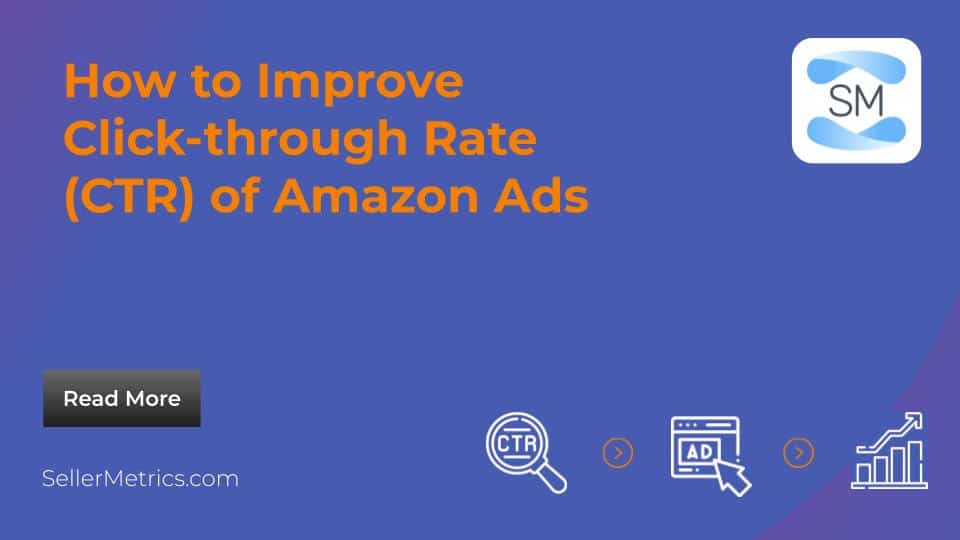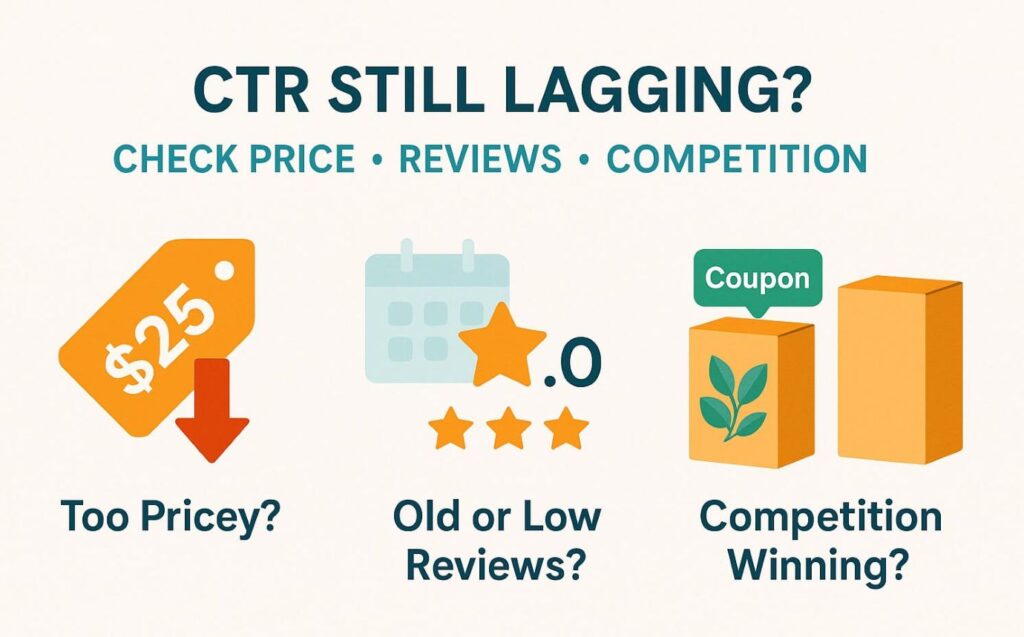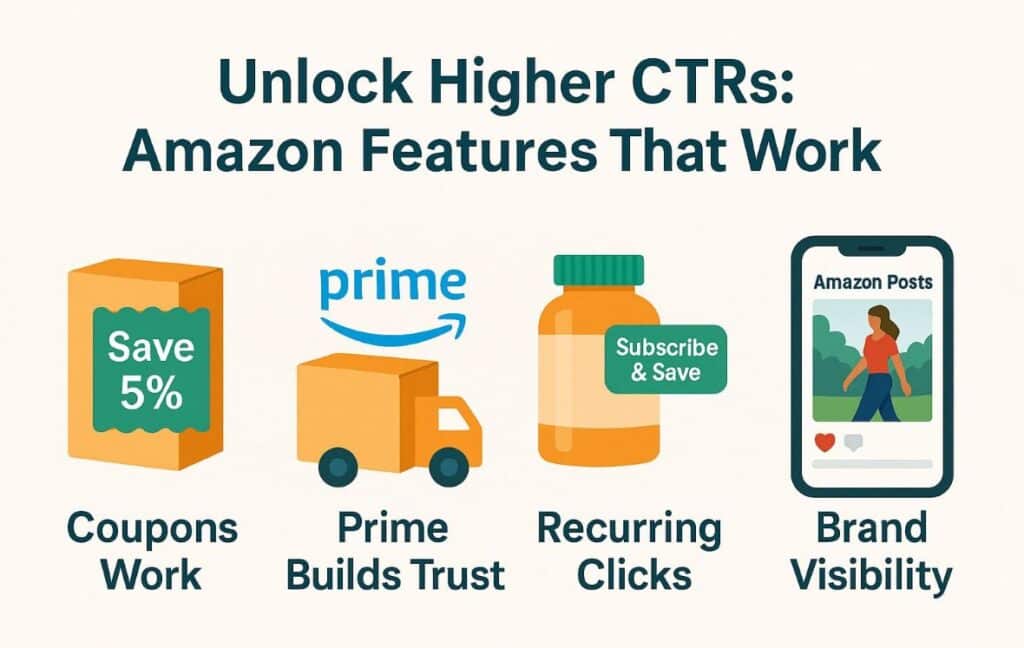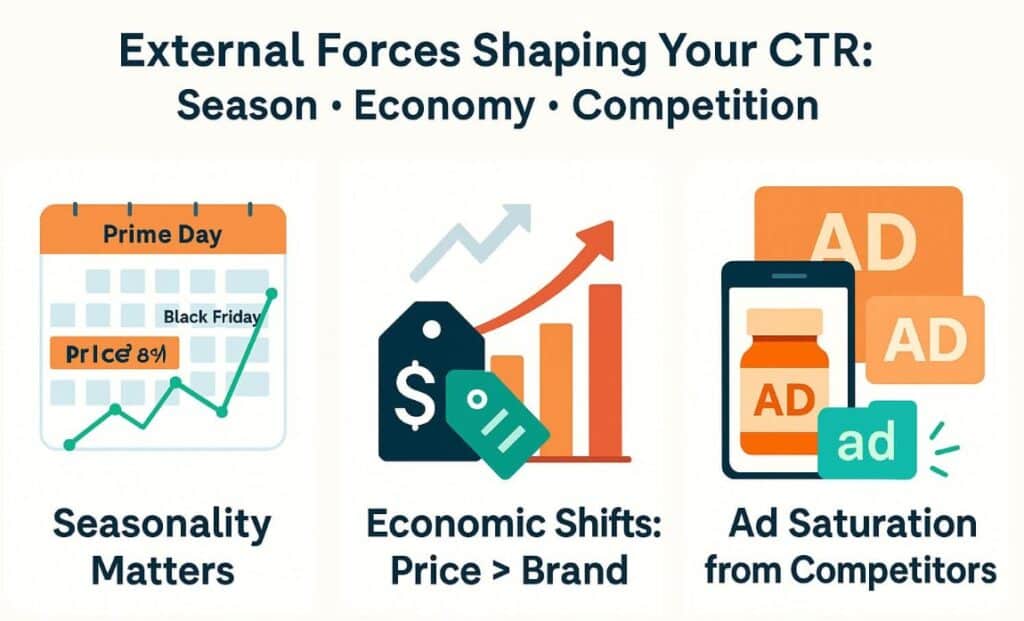10 October 2025
What Shopify Apps Help with GEO Optimization?
TweetLinkedInShareEmailPrint Introduction The way customers discover and shop online is changing faster than ...

Click-through rate (CTR) is one of the most important performance metrics for your Amazon Ads. At its core, CTR tells you how often shoppers who see your ad actually click on it. While it may seem like just another number in Seller Central, CTR is far more than a vanity metric. It’s a direct indicator of how well your ads are resonating with potential buyers. Think about it: if 1,000 shoppers see your ad but only 3 click, that’s a wasted opportunity.
A strong CTR means your ad is relevant, compelling, and aligned with shopper intent. A weak CTR, on the other hand, usually signals that something is off—your targeting, your product detail page, your creative, or even external market conditions. And here’s the kicker: CTR doesn’t just reflect ad performance; it actually impacts your ad costs. Higher CTRs typically lead to lower cost per click (CPC), stronger ad rank, and ultimately better return on ad spend (ROAS).
In this comprehensive guide, we’ll walk you through the real reasons why your Amazon Ads may be underperforming, benchmarks you can use to gauge what’s “good” vs. “bad,” and proven strategies to boost CTR in a sustainable way. Whether you’re new to Amazon PPC or running ads at scale, these insights will help you turn impressions into actual revenue.
Article Contents

Before diving into advanced tactics, let’s start with the basics. In many cases, low CTRs aren’t the result of some complex advertising flaw but rather a few fundamental missteps. Fixing these can provide a quick boost.
Relevance is everything on Amazon. If your ads are showing up for the wrong keywords, you’re wasting impressions and lowering your CTR. For example, targeting a broad keyword like “running shoes” may place your ad against hundreds of irrelevant queries, while something specific like “women’s cushioned marathon shoes” matches shopper intent more directly.
The Amazon Search Query Performance Report (SQPR) is an excellent tool for diagnosing this problem. It shows you how often your brand appears in search results and how often shoppers click. If you notice impressions but no clicks, your targeting is too broad. Tighten your match types, add negative keywords, and prioritize queries where you’ve historically performed well.
Your product title is the first thing shoppers read after the image. A weak, keyword-stuffed, or confusing title will repel clicks. Titles need to strike a balance: include your primary keywords, but also be clear, concise, and consumer-friendly.
For instance, compare:
The second is more readable, includes purchase intent keywords, and conveys benefits. Try reading your title aloud. If it sounds awkward or robotic, shoppers will feel the same way. Remember, the title is your headline. Make it click-worthy.
CTR is partly determined by where your ad shows up. Ads buried on the second page rarely get clicks. Amazon uses an auction system where Ad Rank is influenced by your bid, expected CTR, and conversion rate.
If your CTR is low because you’re not securing premium placements, you may need to increase bids strategically. Placement modifiers (Top of Search, Product Detail Pages, Rest of Search) can also help. Data shows that Top of Search placements can generate up to 2x the CTR compared to other placements, but they require higher bids. If you consistently show up on page two, your CTR will always suffer because most shoppers rarely make it past page one.
Images sell products on Amazon. According to internal Amazon studies, over 75% of purchase decisions are based on the first image shoppers see. If your hero image isn’t high-resolution, doesn’t clearly showcase your product, or fails to stand out, shoppers won’t click. Would you click on a blurry image when right next to it is a crisp, professional photo? Neither will your customers.
Invest in professional photography. Show your product in use, ensure the background is pure white, and test multiple variations using Amazon’s Manage Your Experiments tool. Often, simply swapping in a more compelling main image can increase CTR by 20–30%.
Here’s something many sellers overlook: CTR is relative. A 0.35% CTR might be poor in one category but excellent in another. Before panicking about “low” CTR, benchmark your performance against industry norms.
Why the difference? Sponsored Brands take up more real estate, feature your logo and custom headline, and usually have higher CTRs. Sponsored Display often targets shoppers outside Amazon or on product pages where intent is weaker, leading to lower CTRs.
CTR also varies widely by product category. For example:
So don’t panic if your CTR looks low at first glance; it might actually be average for your category. Use these benchmarks as a reference point. If your CTR is below category averages, you have optimization work to do. If you’re above average but still struggling with profitability, the issue may lie with conversion rate or pricing rather than CTR.

Sometimes you’ve done everything right—keywords, titles, images—but CTRs remain stubbornly low. That’s when it’s time to dig deeper.
Amazon is a price-driven marketplace. If your product is priced significantly higher than comparable items, CTR will drop regardless of how polished your listing is. A shopper may be intrigued by your ad, but will bypass it once they see the price.
Tools like Amazon Automate Pricing, Jungle Scout, or Helium 10 can help you track competitor prices. Small adjustments, even $1–$2, can make a meaningful impact on CTR, especially in commoditized niches. A $2 price difference may not sound like much, but on Amazon, it can sway a shopper instantly.
Reviews are social proof. According to a PowerReviews survey, 94% of shoppers say product reviews influence their buying decisions. On Amazon, the threshold is clear: products with an average rating below 3.5 stars suffer massive CTR penalties. Shoppers often glance at stars before they even read your title. A 3-star rating can stop clicks cold.
Boosting reviews isn’t just about quantity but recency. If your last review is three months old, shoppers may think the product is outdated. Use Amazon Vine, request reviews via the “Request a Review” button in Seller Central, and ensure your customer service follow-up is generating positive feedback.
Markets evolve quickly on Amazon. A competitor launching with aggressive pricing, coupons, or better images can siphon clicks away from your ads.
Conduct regular competitor audits:
If they’re offering something you aren’t, like a discount badge or premium packaging, it could explain your declining CTR.

Amazon provides built-in features that, when used strategically, can dramatically increase CTR.
The green coupon badge is a proven attention-grabber. Even if the discount is modest, shoppers are far more likely to click when they see savings. Internal Amazon data suggests that ads with coupons can achieve CTR lifts of 20–40%compared to those without. That little green badge often feels like free money to customers.
Shoppers trust the Prime badge. It signals fast, free shipping and Amazon-backed reliability. Studies show that Prime-eligible products enjoy CTRs up to 25% higher than non-Prime listings. If you’re not already using FBA or ensuring Prime eligibility, you’re handicapping your ads.
For consumable products such as vitamins, supplements, and household goods, Subscribe & Save can boost CTR. The program not only locks in recurring revenue but also signals convenience and cost savings, making shoppers more likely to click. Many buyers join Subscribe & Save not just for savings, but so they don’t forget to reorder essentials.
Amazon Posts allow you to publish lifestyle content directly on Amazon. While not a direct ad unit, Posts increase brand visibility and familiarity. A shopper who has engaged with your Posts before is more likely to click your ad later, improving long-term CTR performance. Think of Posts as Instagram for Amazon—free brand exposure that pays off later.

Not all CTR issues are under your control. Sometimes external factors play a major role.
Imagine the surge of clicks on Black Friday compared to a random Tuesday in February. CTR naturally fluctuates around key shopping events. Prime Day and Black Friday typically deliver higher CTRs because shoppers are actively seeking deals. Post-holiday months may show declines as consumer spending dips. Plan for these shifts when evaluating performance.
Macroeconomic trends also matter. During periods of inflation, shoppers prioritize price over brand. Supply chain issues can make shoppers more willing to click on available products, even if they’re not the perfect fit. Understanding buyer psychology during these times helps set realistic CTR expectations.
If a competitor floods the market with ads, impressions for your keywords may rise, but CTR falls because you’re no longer standing out. This is why monitoring Share of Voice and Impression Share is critical. Adjust your bids, creatives, or budget allocation to remain competitive.
Once you’ve tackled the fundamentals, advanced diagnostics can uncover hidden opportunities.
The more granular your tracking, the more precise your optimizations can be.
Improving CTR on Amazon is both an art and a science. It requires data-driven targeting, compelling creative assets, competitive pricing, and ongoing monitoring of both internal and external factors. Sellers who prioritize CTR don’t just see better ad performance but build stronger brand equity and gain an edge in Amazon’s hyper-competitive marketplace.
If you’re serious about maximizing the performance of your Amazon Ads, now is the time to audit your campaigns, benchmark your CTRs, and start testing new strategies. The difference between a 0.3% and 0.6% CTR could be the difference between breaking even and scaling profitably. Even a small CTR lift can mean thousands more clicks over time.
It depends on the ad type and category. Sponsored Products typically average 0.35–0.45%, while Sponsored Brands can reach 0.55–0.65%.
In most cases, yes. Even small discounts displayed via a coupon badge can significantly improve click-through rates.
Use the Amazon Advertising console, placement reports, and the Search Query Performance Report for granular tracking.
Yes. Higher CTR improves sales velocity, which is a key factor in Amazon’s A9 ranking algorithm.
Not immediately. First, diagnose the reason: irrelevant targeting, poor images, or external competition. Some ads may have strategic value even at lower CTRs.
Both matter. High star ratings boost CTR, while large volumes of recent reviews build trust.
Yes, because it targets shoppers across different stages of the funnel. Expect lower CTR but potential brand awareness benefits.
At least quarterly, or sooner if CTR trends downward. Testing new images or titles keeps ads fresh.
Absolutely. Prime products consistently outperform non-Prime listings in click-through rate.
Indirectly, yes. Driving shoppers to your store from Google or social channels can increase brand recognition, which makes shoppers more likely to click your ads later.